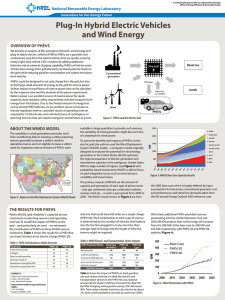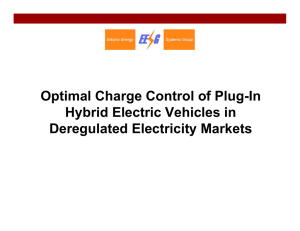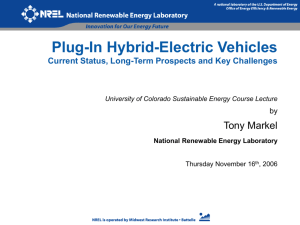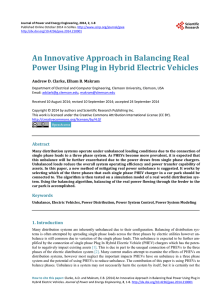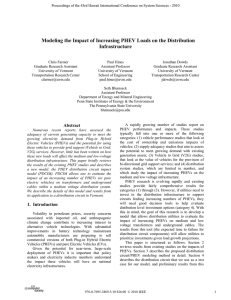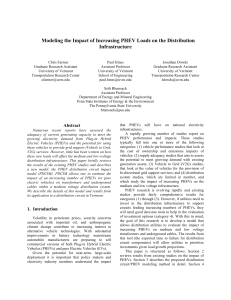Document 12861552
advertisement
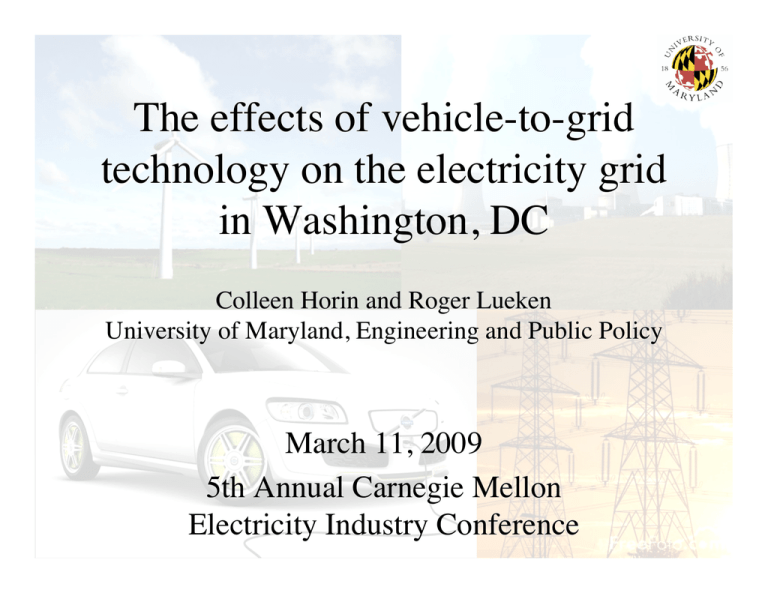
The effects of vehicle-to-grid technology on the electricity grid in Washington, DC Colleen Horin and Roger Lueken University of Maryland, Engineering and Public Policy March 11, 2009 5th Annual Carnegie Mellon Electricity Industry Conference Outline • • • • • Background and problem description Approach and methods Model construction Results Conclusions / future work Background: The problem • The V2G storage option supposes that if electric vehicles become widespread, they could provide fast-response intermediate and peak load power to the grid while not on the road. 6000 Power (MW) • Storage is critical to integrating variable and clean sources of energy into the electricity grid Load: Summer 7000 5000 4000 3000 2000 1000 0 1 3 5 7 9 11 13 15 17 19 21 Hour • Used stochastic programming to model PHEV and wind scenarios Goal: Model implications of V2G on Washington DC electric grid 23 Background: The Washington, DC Region eGRID power plant information and PJM load Profiles for PEPCO National Household Travel Survey information about trip patterns U.S. Census data on car ownership and population Wind profiles from NOAA Method: Stochastic Modeling and Electric Power • Stochastic modeling accounts for uncertainties in system variables • One method of stochastic modeling, chance constrained programming, solves problems of the basic form: P(A(x) > b) > α – Where A(x) and/or b is a random variable • In electric power, A(x) represents generation, b represents load, and α is the probability with which the generation at any given time is greater than the load Model Assumptions • There is already a PHEV charging infrastructure in place (so that cars may charge whenever they are not in use) • All PHEV’s are the Chevy Volt (16 kWh battery) • There are no transaction costs or inefficiencies involved in charging and discharging batteries • Consumers are willing to sell-back as long as utility meets the minimum charge constraint for the hour • Wind has no variable costs Model Construction • Chance-constrained program Minimize system cost s.t. at each time period, P(Power Gen +PHEV discharge> Load + PHEV charge) > reliability • Deterministic equivalent Minimize system cost s.t. at each time period, Power Gen > µLoad + net changePHEV charge +z * σLoad • Where the objective function (system cost) is: System Cost = ΣtimeΣplants(Operation costs + Fuel costs + Fixed costs + Startup costs) • Other constraints: – Any change in collective PHEV charge cannot exceed total charge of all PHEV’s connected to the charging infrastructure at a given time, nor can it go below the projected demand for charge from PHEV’s in the next hour – Plants must pay a start up cost when turning on (but not required for plants operating continuous baseload) Results 1. PHEV market penetration: How does PHEV market penetration affect the electric grid? 2. Wind: How might V2G help intermittent renewable resources penetrate the market? 3. Carbon pricing: How would a price on carbon affect the types of power plants the utility uses? Results: PHEV Market Penetration Scenario System savings (%) BAU N/A Peaking Plants 10% PHEVs 4% 25% PHEVs 9.6% 50% PHEVs 9.6% Spare Capacity • Increasing V2G penetration eliminates need for peaking plants. • Benefits from V2G max out after 25% PHEV penetration Results: Wind Power Integration Electricity Load: 5000 Turbines and no PHEVs 8000 • Typical wind profile from Appalachian wind farm • ~10% of total capacity Peaking Plants 7000 Power (MW) 6000 5000 Wind 4000 3000 2000 Wasted Wind Power 1000 0 1 3 5 7 9 11 13 15 17 19 21 23 Hour Electricity Load: 5000 Turbines and 25% PHEVs • Savings: 16% • Reduces required generating units from 9 to 2 8000 7000 Power (MW) 6000 PHEVs Wind 5000 4000 3000 2000 1000 0 1 3 5 7 9 11 13 15 17 19 21 23 With 20,000 turbines (~40% of total capacity) and 50% PHEVs, savings increase to 36% Hour V2G allows more efficient integration of wind power Results: Carbon Pricing Scenario: (Summer) No carbon price System Cost (0% PHEVs) $1,898,000 System Cost (25% PHEVs) Savings (Percentage) $1,716,000 $182,000 Active Generators: 10 Active Generators: 9 (9.6%) $25/tonCO2 $2,127,000 $1,716,000 $411,000 price Active Generators: 11 Active Generators: 9 (19%) $100/tonCO2 $2,530,000 $1,716,000 $813,000 carbon price Active Generators: 12 Active Generators: 9 (32%) V2G makes high carbon prices more affordable by allowing greater dispatch flexibility. Conclusions • To maximize social benefit from V2G system – PHEV purchases must be encouraged – Charging infrastructure must be created – Optimal charging patterns must be encouraged • V2G reduces costs of operating the electricity grid – However, storage savings to variable costs are MINIMAL ($40/car/ year) – Regulation services savings may be higher (>$2,000/car/year)1 • V2G enables large deployment of variable renewables, efficient adaptation to carbon prices, and adoption of PHEVs. • V2G improves utilization of existing assets, reducing need for additional generating and transmission capital expenditures. 1 Kempton, W., California Air Resources Board & California EPA, June 2001 Future Work Model Improvements • Include transient effects & ramping speeds • Battery degradation • Include value of provided regulation services Policy/Economic Modeling • Understand most effective distribution of V2G benefits amongst utilities and consumers • Funds required to develop charging infrastructure • Appropriate subsidy levels to encourage PHEV adoption • Hourly price signals necessary to ensure desired consumers charge in an optimal fashion • Quantify effects of V2G on electricity prices Questions? Backup Slides Results: Increasing Reliability (Z) Higher Z raises average demand; PHEVs at charge storage limits Model Construction: GAMS code Obj_Fn .. Sys_Cost =e= sum(k, sum(t, P(k,t)*(G(k,'OC') + G(k,'FC') + G(k,'fuel') + CTax*G(k,'CO2')) + SCVar(k,t))); Const1(k,t) .. Const2a(k,t) .. Const2b(k,t) .. Const3a(k,t) .. Const3b(k,t) .. P(k,t) =l= BigM*V(k,t); SCVar(k,t) =l= G(k,'Pmin')*G(k,'SC') * (V(k,t) - V(k,t--1)) + BigM * V(k,t--1); SCVar(k,t) =g= G(k,'Pmin')*G(k,'SC') * (V(k,t) - V(k,t--1)); P(k,t) =l= G(k,'Pmax') + BigM * (1 - V(k,t)); P(k,t) =g= G(k,'Pmin') - BigM * (1 - V(k,t)); Const5(t) .. Const6(t) .. Lmean(t) =e= H(t,'LavgSum'); Lstddev(t) =e= H(t,'LstdvSum'); PHEV1(t).. PHEV2(t).. PHEV3(t).. PHEVcharge(t) =e= PHEVcharge(t--1) + deltaPHEV(t); PHEVcharge(t) =g= PHEVmktpen*H(t,'PHEVmin'); PHEVcharge(t) =l= PHEVmax*POVtot*PHEVmktpen; Prob_Const(t).. sum(k,P(k,t)) =g= Lmean(t) + z * Lstddev(t) - WindFract*(H(t,'WindAvg') + z*H(t,'WindStd')) + deltaPHEV(t); Output1(t) .. WindPwr(t) =e= WindFract*(H(t,'WindAvg')); Output2 .. NumPHEVs =e= POVtot*PHEVmktpen; Output3(t) .. MinPHEV(t) =e= H(t,'PHEVmin'); Model test /all/; Solve test using mip minimizing Sys_Cost; Data Sources Data Source Data EPA PEPCO power plant capacities, operating costs, CO2 emissions PJM PEPCO electricity load profiles NOAA Wind profiles (Borden Mountain, MA) NHTS (National Household Travel Survey) Number of vehicles in DC metropolitan area making trips during each hour U.S. Census Number of vehicles in DC metropolitan area Wikipedia PHEV specifications (charge capacity, charge rate) Abrell, Kunz, Weigt* Start up cost estimates for plants Ozturk** Chance-constrained to deterministic equivalent Model Construction • Objective Function: Minimize system costs Sys_Cost = ΣtimeΣplants (Op_costs + Fuel_costs + Fixed_costs + Startup_Cost) • Each plant’s generation is within capacity limits Pmin < Power_level < Pmax • Plant must pay startup cost when turning on If P(t) > 0 and P(t-1) = 0, then SC=startup cost, else SC=0 • Battery levels are within capacity limits MinCharge < Charge < MaxCharge • Generation meets load with set reliability Σplants (Pwr_level) + Wind > Load_mean + z*Load_stddev +PHEVcharge
